
If you are looking for the best foods to vitamin treat health problems, you’ve come to the right place. This article covers foods rich in vitamin C, A, E, and D. If you’re not sure which foods are high in these vitamins, read on to find out! Then, be sure to keep a list of these foods in your kitchen! Then, you’ll know exactly what to eat more of, too!
Sources of vitamin C
There are many sources of vitamin C, but fruits and vegetables are the best for your diet. Even though vitamin C is essential for your health, other food groups contain small amounts of it. For example, a small serving of red bell pepper contains 100 percent of your DV of vitamin C. Supplements can cause some side effects. Foods are the best source of vitamin C, because they are often high in other nutrients.
Although deficiency in vitamin C is rare, it can lead to the condition known as scurvy. This disease is marked by weakness and can affect people of any age. Research has also linked vitamin C deficiency to stress. People who smoke and drink alcohol have lower vitamin C levels than non-smokers. This is because smoking damages mucous membranes and increases inflammation. If you have a vitamin C deficiency, it is important to supplement your diet. カマグラ ゴールド 通販 boosts the immune system and keeps you healthy and prevents infection.
Sources of vitamin A
The human body needs vitamin A to function properly. It is unable to produce vitamin A on its own, so it must be obtained through the diet. Animal livers are some of the richest dietary sources of vitamin A. Liver is where the body stores the vitamin, so a 3-ounce serving of pan-fried beef liver has more than six thousand micrograms of vitamin A. This is 731% of the recommended daily value for adults.
The body requires this fat-soluble vitamin to maintain a normal level of cell reproduction and differentiation. It is required for good vision, strong immune function, and healthy skin. Vitamin A deficiency is considered one of the leading causes of blindness in children and is a problem only in developing countries. Besides these, overconsumption can lead to symptoms such as jaundice, poor appetite, and nausea.
The dietary sources of vitamin A vary. Meat rich in vitamin A, like lamb liver, may be a good source for people suffering from vision problems. Cod liver oil is also an excellent source of vitamin A, and contains 4,080 mcg of preformed vitamin A. Cod liver oil is a great source of vitamin D as well, with 170% of the recommended daily value. Vitamin D plays a vital role in bone health and immunity and may also help prevent depression.
Sources of vitamin E
Foods rich in vitamin E are widely available and include cereal grains, nuts, and seeds. Wheat germ oil is another source of vitamin E that is easy to consume and has numerous health benefits. To get the recommended daily allowance, eat 15-19 milligrams of vitamin E, or about 22.5 IU. Vitamin E has several isomers, but alpha-tocopherol is the most beneficial. This form is highly concentrated and therefore provides more health benefits than any other type of vitamin E.
People with chronic diseases such as cystic fibrosis are especially at risk for vitamin E deficiency. People with undiagnosed celiac disease and liver diseases may also be deficient in vitamin E. Gluten can also cause small intestine damage. Getting enough vitamin E from food is vital for maintaining good health. And while vitamin E supplements are available, there are risks involved as well as benefits.
Vitamin E is an essential nutrient that improves immune function, helps prevent inflammation and promotes cell signaling. It helps widen blood vessels and prevent excessive clotting. It may also alleviate symptoms of PMS, such as pain in the menstrual cycle and dysmenorrhea. Research has shown that vitamin E may improve these symptoms, although this has not been proven. However, people with gastrointestinal conditions may require additional vitamin E supplements. Try it today. Improve health with か まぐ ら 100 購入.
Sources of vitamin D
The National Health and Nutrition Examination Survey (NHANES) found that most people have sufficient levels of vitamin D. But there are many people who are at risk for vitamin D deficiency or inadequacy. In the United States, the level of vitamin D in the blood was stable between 2003 and 2014.
The sun provides vitamin D to our bodies, but window glass blocks out UVB light, making it difficult for us to obtain sufficient amounts of this essential vitamin. Although vitamin D is produced in the body when exposed to sunlight, it can be diluted and turned into non-active forms. Vitamin D is also found in some foods, such as some fish, egg yolks, and fish liver oils. Fortified dairy products contain high amounts of vitamin D.
Sunlight is the best source of vitamin D. However, there are many factors that can decrease the amount of vitamin D in the blood. For example, skin color reduces the ability of the skin to absorb UVB rays, making it difficult to synthesize vitamin D from the sun. Also, older adults spend less time outside, limiting the amount of vitamin D produced in their skin. To check vitamin D levels in the blood, they can undergo a simple blood test.















